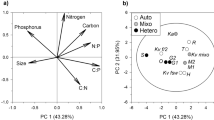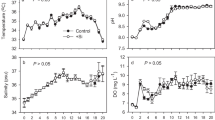Abstract
The feeding selectivity and the growth and reproductive success of the copepod Acartia tonsa have been studied in mesocosms fertilized at different Si:N ratios (0–1.75:1) and, therefore, at different compositions of the phytoplankton communities. Phytoplankton composition showed a strong response to nutrient ratios, with diatoms comprising >90% at Si:N ratios >1:1 of total biomass as opposed to <20% at the lowest ratio. A. tonsa strongly preferred feeding on motile prey (flagellates and ciliates) to feeding on diatoms. Nevertheless, diatoms comprised a substantial part of the diet at the highest Si:N ratios. A. tonsa egg production and the final (after 4 weeks) abundance of adults and copepodites showed no response to Si:N ratios while nauplii production slightly increased with Si:N ratios. It is concluded that the frequently reported deleterious effect of diatoms on copepod reproduction is rather unusual when copepods are confronted with a naturally diverse phytoplankton assemblage instead of clonal cultures in the laboratory.







Similar content being viewed by others
References
Ban S, Burns C, Castel J, et al. (1997) The paradox of diatom copepod interactions. Mar Ecol Prog Ser 157:287–293
Besiktepe S, Dam HG (2002) Coupling of ingestion and defecation as a function of diet in the calanoid copepod Acartia tonsa. Mar Ecol Prog Ser 229:151–164
Calbet A, Landry MR (2004) Phytoplankton growth, microzooplankton, and carbon cycling in marine systems. Limnol Oceanogr 49:51–57
Chaudron Y, Poulet SA, Laabir M, et al. (1996) Is hatching success of copepod eggs diatom density-dependent? Mar Ecol Prog Ser 144:185–193
Colin SP, Dam HG (2007) Comparison of the functional and numerical responses of resistant versus non-resistant populations of the copepod Acartia hudsonica fed the toxic dinoflagellate Alexandrium tamarense. Harmful Algae 6:875–882
Dam HG, Colin SP (2005) Prorocentrum minimum (clone Exuv) is nutritionally insufficient, but not toxic to the copepod Acartia tonsa. Harmful Algae 4:575–584
Egge JK, Jacobsen A (1997) Influence of silicate on particulate carbon production in phytoplankton. Mar Ecol Prog Ser 147:219–230
Fontana A, d’Ippolito G, Cutignano A, et al. (2007) LOX-induced lipid peroxidation mechanism responsible for the detrimental effect of marine diatoms on zooplankton grazers. Chem Biochem 8:1810–1818
Frangoulos M, Guisande C, Maneiro I, et al. (2000) Short-term and long-term effects of the toxic dinoflagellate Alexandrium minutum on the copepod Acartia clausi. Mar Ecol Prog Ser 203:161–169
Henriksen CI, Saiz E, Calbet A, et al. (2007) Feeding activity and swimming patterns of Acartia grani and Oithona davisae nauplii in the presence of motile and non-motile prey. Mar Ecol Prog Ser 331:119–129
Hillebrand H, Duerselen C-D, Kirschtel D, Pollingher U, Zohary T (1999) Biovolume calculation for pelagic and benthic microalgae. J Phycol 35:403–424
Ianora A, Poulet SA, Miralto A (1995) A comparative study of the inhibitory effect of diatoms on the reproductive biology of the copepod Temora stylifera. Mar Biol 125:279–286
Ianora A, Poulet SA, Miralto A (2003) The effects of diatoms on copepod reproduction. A review. Phycologia 42:351–363
Ianora A, Miralto A, Poulet SA, et al. (2004) Aldehyde suppression of copepod recruitment in blooms of a ubiquitous planktonic diatom. Nature 429:403–407
Irigoien X, Harris RP, Verheye HM, et al. (2002) Copepod hatching success in marine ecosystems with high diatom concentrations. Nature 419:387–389
Irigoien X, Head RN, Harris RP, et al. (2000) Feeding selectivity and egg production of Calanus helgolandicus in the English Channel. Limnol Oceanogr 45:44–54
Irigoien X, Titelman J, Harris RP, et al. (2003) Feeding of Calanus finmarchicus nauplii in the Irminger Sea. Mar Ecol Prog Ser 262:193–200
Irigoien X, Verheye HM, Harris RP, et al. (2005) Effect of food composition on egg production and hatching success rate of two copepod species (Calanoides carinatus and Rhincalanus nasutus) in the Benguela upwelling system. J Plankton Res 27:735–742
Iverson RL (1990) Control of marine fish production. Limnol Oceanogr 35:1593–1604
Jónasdottir SH, Kiørboe T (1996) Copepod recruitment and food composition: do diatoms affect hatching success? Mar Biol 125:743–750
Jonasdottir SH, Gudfinnsson HG, Gislason, Astthorsson OS (2002) Diet composition and quality for Calanus finmarchicus egg production and hatching success off south-west Iceland. Mar Biol 140:1195–1206
Jones RH, Flynn KJ, Anderson TR (2002) Effect of food quality on carbon and nitrogen growth efficiency in the copepod Acartia tonsa. Mar Ecol Prog Ser 235:147–156
Kiørboe T, Saiz E, Viitasalo M (1996) Prey switching behaviour in the planktonic copepod Acartia tonsa. Mar Ecol Prog Ser 143:65–75
Klein Breteler WCM, Schogt N, Rampen S (2005) Effect of diatom nutrient limitation on copepod development: role of essential lipids. Mar Ecol Prog Ser 219:125–130
Knuckey RM, Semmens GL, Mayer RJ, et al. (2005) Development of an optimal microalgal diet for the culture of the calanoid copepod Acartia sinjiensis: effect of algal species and feed concentration on copepod development. Aquaculture 249:339–351
Koski M, Klein Breteler WCM (2003) Influence of diet on copepod survival in the laboratory. Mar Ecol Prog Ser 264:73–82
Koski M, Wichard T, Jónasdottir SH (2008) “Good” and “bad” diatoms: development, growth, and juvenile mortality of the copepod Temora longicornis on diatom diets. Mar Biol 154:719–734
Legendre L (1990) The significance of microalgal blooms for fisheries and export of particulate organic carbon in the oceans. J Plankton Res 12:681–699
Maneiro I, Iglesias P, Guisande C, et al. (2005) Fate of domoic acid ingested by the copepod Acartia clausi. Mar Biol 148:123–130
Mauchlin J (1998) The biology of calanoid copepods. Academic Press, San Diego
McLaren IA (1966) Predicting development rates of copepod eggs. Biol Bull 131:457–469
McLaren IA (1978) Generation lengths of some temperate marine copepods–estimation, prediction and implications. J Fish Res Board Can 35:1330–1342
McLaren IA, Corkett CJ, Zillioux EJ (1969) Temperature adaptations of copepod eggs from the arctic to the tropics. Biol Bull 137:486–493
Menden-Deuer S, Lessard EJ (2000) Carbon to volume relationships for dinoflagellates, diatoms, and of the protist plankton. Limnol Oceanogr 45:569–579
Meyer-Harms B, Irigoien X, Head R, Harris R (1999) Selective feeding on natural phytoplankton by Calanus finmarchicus before, during, and after the 1997 spring bloom in the Norwegian Sea. Limnol Oceanogr 44:154–165
Miralto A, Barone G, Romano G, et al. (1999) The insidious effect of diatoms on copepod reproduction. Nature 402:173–176
Miralto A, Guglielmo L, Zagami G, et al. (2003) Inhibition of population growth in the copepods Acartia clausi and Calanus helgolandicus during diatom blooms. Mar Ecol Prog Ser 254:253–268
Nejstgaard JC, Gismervik I, Solberg PT (1997) Feeding and reproduction by Calanus finnmarchicus, and microzooplankton grazing during mesocosm blooms of diatoms and the coccolithophore Emilinana huxleyi. Mar Ecol Prog Ser 147:197–217
Paffenhöfer GA, Ianora A, Miralto A, et al. (2005) Colloquium on diatom–copepod interactions. Mar Ecol Prog Ser 286:293–305
Pierson JJ, Halsband-Lenk C, Leising AW (2005) Reproductive success of Calanus pacificus during diatom blooms in Dabob Bay, Washington. Prog Ocean 67:314–331
Pohnert G (2000) Wound-activated chemical defence in unicellular planktonic algae. Angew Chem Int Ed 39:4352–4354
Poulet SA, Ianora A, Miralto A, Meijer L (1994) Do diatoms arrest embryonic development in copepods? Mar Ecol Prog Ser 111:79–96
Poulet SA, Cueff A, Wichard T, et al. (2007a) Influence of diatoms on copepod reproduction. III. Consequences of abnormal oocyte maturation on reproductive factors in Calanus helgolandicus. Mar Biol 152:415–428
Poulet SA, Escribano R, Hidalgo P, et al. (2007b) Collapse of Calanus chilensis reproduction in a marine environment with high diatom concentration. J Exp Mar Biol Ecol 352:187–199
Poulet SA, Wichard T, Ledoux JB, et al. (2006) Influence of diatoms on copepod reproduction. I. Field and laboratory observations related to Calanus helgolandicus egg production. Mar Ecol Prog Ser 308:129–142
Riley GA (1957) Phytoplankton of the North Central Sargasso Sea. Limnol Oceanogr 2:252–270
Saiz E, Kiørboe T (1995) Predatory and suspension feeding of the copepod Acartia tonsa in turbulent environments. Mar Ecol Prog Ser 122:147–158
Sommer U (1994) The impact of light intensity and daylength on silicate and nitrate competition among marine phytoplankton. Limnol Oceanogr 39:1680–1688
Sommer U (1998) From algal competition to animal production: enhance ecological efficiency of Brachionus with a mixed diet. Limnol Oceanogr 43:1393–1396
Sommer U, Sommer F (2006) Cladocerans versus copepods: the cause of contrasting top-down controls in freshwater and marine phytoplankton. Oecologia 147:183–194
Sommer U, Stibor H, Katechakis A, Sommer F, Hansen T (2002) Pelagic food web configuration at different levels of nutrient richness and their implications for the ratio fish production:primary production. Hydrobiologia 484:11–120
Sommer U, Hansen T, Stibor H, Vadstein O (2004) Presistence of phytoplankton responses to different Si:N ratios under mesozooplankton grazing pressure: a mesocosm study with NE Atlantic plankton. Mar Ecol Prog Ser 278:67–75
Sommer U, Hansen T, Blum O, Holzner N, Vadstein O, Stibor H (2005) Copepod and microzooplankton grazing in mesocosms fertilised with different Si:N ratios: no overlap between food spectra and Si:N influence on zooplankton trophic level. Oecologia 142:274–283
Sommer U, Aberle N, Engel A, Hansen T, Lengfellner K, Sandow M, Wohlers J, Zöllner E, Riebesell U (2007) An indoor mesocosm system to study the effect of climate change on the late winter and spring succession of Baltic Sea phyto- and zooplankton. Oecologia 150:655–667
Takahashi K, Tiselius P (2005) Ontogenetic change of foraging behaviour during copepodite development of Acartia clausii. Mar Ecol Prog Ser 303:213–223
Thor P, Cervetto G, Besiktepe S, et al. (2002) Influence of two different green algal diets on specific dynamic action and incorporation of carbon into biochemical fractions in the copepod Acartia tonsa. J Plankton Res 24:293–300
Tilzer M (1983) The importance of fractional light absorption by photosynthetic pigments for phytoplankton productivity in Lake Constance. Limnol Oceanogr 28:833–846
Tirelli V, Mayzaud P (2005) Relationship between functional response and gut transit time in the calanoid copepod Acartia clausi: role of food quantity and quality. J Plankton Res 27:557–568
Tiselius P, Jonsson PR (1990) Foraging behaviour of six calanoid copepods: observations and hydrodynamic analysis. Mar Ecol Prog Ser 66:22–33
Utermöhl H (1958) Zur Vervollkommnung der quantitativen Phytoplankton Methodik. Mitt Int Ver Theor Angew Limnol 9:263–272
Vargas C, Escribano R, Poulet SA (2006) Phytoplankton food quality determines time-windows for successful zooplankton reproductive pulses. Ecology 87:2992–2999
Wichard T, Poulet SA, Halsband-Lenk C, et al. (2005) Survey of the chemical defence potential of diatoms: screening of fifty-one species for α, β, γ, δ-unsaturated aldehydes. J Chem Ecol 31(4):949–958
Acknowledgements
This research has been supported by the DFG grant So 145/25-1. Technical assistance by Thomas Hansen and Cordula Meyer is gratefully acknowledged.
Author information
Authors and Affiliations
Corresponding author
Additional information
Communicated by Sebastian Diehl.
Rights and permissions
About this article
Cite this article
Sommer, U. Copepod growth and diatoms: insensitivity of Acartia tonsa to the composition of semi-natural plankton mixtures manipulated by silicon:nitrogen ratios in mesocosms. Oecologia 159, 207–215 (2009). https://doi.org/10.1007/s00442-008-1193-9
Received:
Accepted:
Published:
Issue Date:
DOI: https://doi.org/10.1007/s00442-008-1193-9




